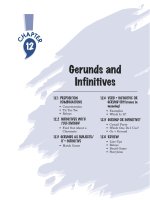Verb patterns with gerunds and have
Bạn đang xem bản rút gọn của tài liệu. Xem và tải ngay bản đầy đủ của tài liệu tại đây (8.13 KB, 1 trang )
Verb patterns with gerunds and have
The
gerund
is the form of the verb ending in
–ing
. Note that the present participle also ends in
–ing.
The gerund is different from the present participle. While the present participle is mainly used as an adjective, the
gerund is used as a noun.
The present participle is also used to form the continuous tenses.
The gerund can be the subject or object of the verb. It can also be the object of a preposition.
In this lesson, we will review some common verb patterns using the gerund. We will also learn about the
causative use of have.
Subject + Verb + Gerund
In this structure the gerund is used as the object of the transitive verb.
I enjoy writing.
I don’t mind cooking.
He prefers walking to riding.
I couldn’t help overhearing their conversation.
She likes reading.
I love playing with my kids.
Gerund after prepositions
A gerund is often placed after a preposition. Note that we cannot use an infinitive after a preposition.
The teacher used a red pen for marking mistakes.
He earns his living by working at a pub.
She is good at singing.
He got married only after getting a good job.
You shouldn’t have left the party without thanking the host.
Are you interested in learning palmistry?
Causative use of ‘have’
Getting something done by somebody else is expressed by the structure
have/get + object + past participle.
I must get the computer fixed.
I had my watch repaired.
You must get your hair cut.
She has had her photograph taken.
Be first to know when grammar rules change! Sign up to our newsletter here: englishgrammar.org (It's free)
Powered by TCPDF (www.tcpdf.org)









